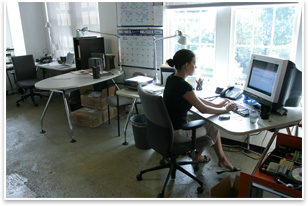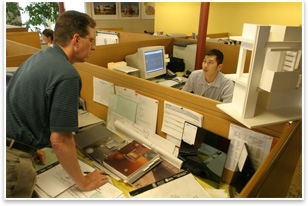practice management
BIM Me Up, Scotty
by Michael Tardif, Assoc. AIA
Contributing Editor
 Building information modeling (BIM) is as much a business process as it is a technology. And because virtually every building project is the work of many people and organizations, any change in business process requires the cooperation of a lot of people in a lot of organizations. There are benefits to implementing BIM within a single firm, but the greatest benefits are realized when BIM is implemented by all members of a project team. Unfortunately, while you can influence other project team members in the means and methods they use to meet their project responsibilities, you can rarely direct them, particularly in their choice of software. You can truly control only what happens within your own firm. Building information modeling (BIM) is as much a business process as it is a technology. And because virtually every building project is the work of many people and organizations, any change in business process requires the cooperation of a lot of people in a lot of organizations. There are benefits to implementing BIM within a single firm, but the greatest benefits are realized when BIM is implemented by all members of a project team. Unfortunately, while you can influence other project team members in the means and methods they use to meet their project responsibilities, you can rarely direct them, particularly in their choice of software. You can truly control only what happens within your own firm.
In the absence of an intergalactic BIM treaty for data exchange, how can you go about implementing BIM? One strategy is to select BIM tools and processes that you can implement independently, ever mindful of their utility for future increased team collaboration—a systems approach that can eventually bridge the gaps among team members.
BIM authoring software
The first decision many firms face is the choice of BIM authoring software, the robust design tools that take the place of CAD software. In the U.S., the most common architectural BIM authoring applications are ArchiCAD by Graphisoft, Bentley Architecture by Bentley Systems, and REVIT by Autodesk. All have related authoring applications (e.g., ArchiCAD Constructor, Bentley Structural, Bentley Building Mechanical Systems, Revit Structure, and Revit Systems) that can be used by the appropriate design professionals to add or link structural or MEP information models to the architectural building information model.
These proprietary suites of BIM authoring tools should be evaluated for how easily information can be shared with other team members but controlled by the authoritative source. They should also be interoperable beyond proprietary boundaries, so that all members of a design team may use whichever application they prefer, and not just the software products of a single manufacturer. At a minimum, an application should support the Industry Foundation Classes (IFCs) of the International Alliance for Interoperability (IAI), the only worldwide, publicly available data format for building information. If not, the application should demonstrate a reliable, alternative method of information exchange and sharing.
 Architecture firms that have developed experience with BIM authoring tools can begin looking ahead to applications that might be called audit, assessment, or analysis tools. These are highly specialized applications that query a building information model and identify interferences (for which “clash detection” is the new buzz phrase), assess a building’s environmental impact, or measure its conformance to a growing array of reference standards such as building codes or accessibility codes. These BIM tools, relatively speaking, require far less time and effort to master than authoring tools. They also generate information early in the design process that you can exploit to your own business advantage, unlike the global but elusive benefits of BIM, which seem to accrue to everyone and no one. Nearly all of these applications are being developed in Europe and Asia and are slow to reach the U.S. market, but two applications are available in the U.S. that are worth exploring. Architecture firms that have developed experience with BIM authoring tools can begin looking ahead to applications that might be called audit, assessment, or analysis tools. These are highly specialized applications that query a building information model and identify interferences (for which “clash detection” is the new buzz phrase), assess a building’s environmental impact, or measure its conformance to a growing array of reference standards such as building codes or accessibility codes. These BIM tools, relatively speaking, require far less time and effort to master than authoring tools. They also generate information early in the design process that you can exploit to your own business advantage, unlike the global but elusive benefits of BIM, which seem to accrue to everyone and no one. Nearly all of these applications are being developed in Europe and Asia and are slow to reach the U.S. market, but two applications are available in the U.S. that are worth exploring.
Solibri Model Checker
Solibri Model Checker, manufactured by the Finnish company of the same name, examines a building information model for integrity, quality, and physical security. It reveals potential flaws or weaknesses in the design and highlights any clashing components. It can be used to determine whether building elements intersect or meet properly, or whether the model conforms to code requirements, space allocation requirements, or user-defined design parameters. It can also be used to compare a structural model to an architectural model of the same building, or a structural model to a building services (MEP) model. Solibri allows the user to generate an illustrated, annotated report in PDF format that identifies interferences and other problems for correction by the authoritative source in the authoring application, and categorizes them by severity.
Jetstream v5
A clash detection and model integration application, Jetstream, a product of British-based Navisworks Ltd., can aggregate information from multiple authoritative sources into a single building model. Individual members of design teams can work independently in the application of their choice, and then compile their models using Jetstream for clash detection. The list of supported file formats is impressive and includes Autodesk’s DWG, DXF, and DWF; Bentley’s DGN, PRP, and PRW; 3D Studio’s 3DS and PRJ; IFC; SketchUp’s SKP; and many HVAC, MEP, and structural design applications. Jetstream generates a clash-detection report that can be used by the design team to resolve clashes. Models are updated by authoritative sources in their native authoring applications and can be repeatedly run through clash detection to confirm that problems have been resolved.
Over time, design teams gain confidence in the quality of their deliverables
The clarity of the information reported by model checkers and the relative ease with which it can be obtained fosters a collaborative climate for resolving design problems, with the added benefit of reducing both actual and perceived risk of professional liability for errors and omissions. Over time, design teams gain confidence in the quality of their deliverables, which builds a culture of even greater trust and collaboration for future projects. Once you know that the information you are sharing is reliable and accurate, you are far more likely to be willing to share it.
Model checkers can be used by anyone—including contractors and owners—to verify the integrity of building models. (The GSA uses it to verify the integrity of models it receives from A/E firms.) But the most logical user is the team member of the authoritative source—the young architect or engineer—who created the model in the first place. By establishing a culture of self-correcting behavior, the skill of individual team members will improve while the burden on supervisors for finding and correcting errors will be reduced. A generation ago, a popular mantra of architecture firm leaders was “Find it on paper, not in the field.” Now you have the ability to find it in the model, before it ever gets to paper.
Copyright 2006 Michael Tardif. Reprinted with permission. |


 Building information modeling (BIM) is as much a business process as it is a technology. And because virtually every building project is the work of many people and organizations, any change in business process requires the cooperation of a lot of people in a lot of organizations. There are benefits to implementing BIM within a single firm, but the greatest benefits are realized when BIM is implemented by all members of a project team. Unfortunately, while you can influence other project team members in the means and methods they use to meet their project responsibilities, you can rarely direct them, particularly in their choice of software. You can truly control only what happens within your own firm.
Building information modeling (BIM) is as much a business process as it is a technology. And because virtually every building project is the work of many people and organizations, any change in business process requires the cooperation of a lot of people in a lot of organizations. There are benefits to implementing BIM within a single firm, but the greatest benefits are realized when BIM is implemented by all members of a project team. Unfortunately, while you can influence other project team members in the means and methods they use to meet their project responsibilities, you can rarely direct them, particularly in their choice of software. You can truly control only what happens within your own firm. Architecture firms that have developed experience with BIM authoring tools can begin looking ahead to applications that might be called audit, assessment, or analysis tools. These are highly specialized applications that query a building information model and identify interferences (for which “clash detection” is the new buzz phrase), assess a building’s environmental impact, or measure its conformance to a growing array of reference standards such as building codes or accessibility codes. These BIM tools, relatively speaking, require far less time and effort to master than authoring tools. They also generate information early in the design process that you can exploit to your own business advantage, unlike the global but elusive benefits of BIM, which seem to accrue to everyone and no one. Nearly all of these applications are being developed in Europe and Asia and are slow to reach the U.S. market, but two applications are available in the U.S. that are worth exploring.
Architecture firms that have developed experience with BIM authoring tools can begin looking ahead to applications that might be called audit, assessment, or analysis tools. These are highly specialized applications that query a building information model and identify interferences (for which “clash detection” is the new buzz phrase), assess a building’s environmental impact, or measure its conformance to a growing array of reference standards such as building codes or accessibility codes. These BIM tools, relatively speaking, require far less time and effort to master than authoring tools. They also generate information early in the design process that you can exploit to your own business advantage, unlike the global but elusive benefits of BIM, which seem to accrue to everyone and no one. Nearly all of these applications are being developed in Europe and Asia and are slow to reach the U.S. market, but two applications are available in the U.S. that are worth exploring.